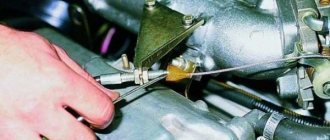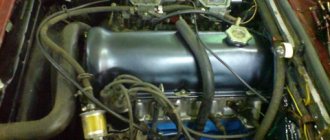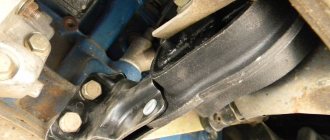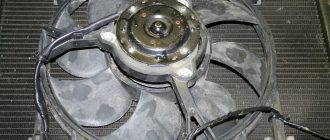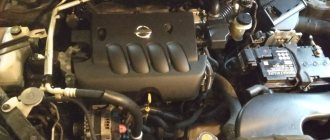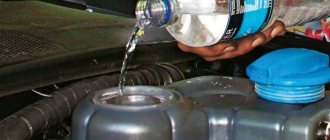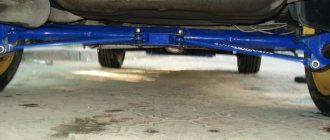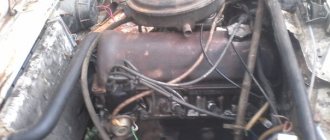The carburetor spacer is a seemingly small part with holes. Installing this “thickened gasket” allows you to achieve increased engine performance while reducing fuel consumption, which is also important.
Equipping trucks and passenger vehicles with this part under the engine carburetor allows you to avoid many problems. When converting an engine to gas equipment, a spacer will be the best solution for equipping a carburetor engine, but even when the engine is running on gasoline, its work is indispensable.
Let's look at the benefits obtained by installing this equipment.
Inset options
In the situation with 2nd generation HBO, the insertion of HBO into the carburetor may vary, and depends primarily on the model of the car. For each specific case, experts consider the most optimal option:
- A simple way is to install a spacer mixer with a divider between the chambers. It is not intended to be inserted into the carburetor body. No need to drill anything. In this way, gas is often inserted into the ozone carburetor. It is necessary to remove the textolite gasket and install the gas mixer. This manipulation can be done with classic types of carburetors. The gas mixer is equipped with a power register. Has two outputs with autonomous adjustments. The register performs a useful function for fine-tuning the gas supply. You can effectively adjust the dynamic characteristics and save gas fuel. This option is very popular due to its simple installation.
- Another simple way is using a faucet, which car owners nicknamed the turtle because of its appearance. There is no need to remove the carburetor during installation. Unscrew the fastening nuts on the air filter, remove the pressure plate and install the turtle. Then all that remains is to put back the unscrewed nuts. The only modification is that you need to drill out the entrance for the gas line in the filter housing. The adjustment is carried out by a dispenser, which has an inlet and an outlet, as well as an adjusting bolt. You must be prepared for some loss of car dynamics when running not only on propane, but also on standard fuel. This factor is inevitable due to the narrowing of the air flow passage. It is possible to expand it by placing washers under the bolts. It will be more difficult to adjust the gas-air mixture using this method. It turns out to be “poor” or oversaturated. The advantage is simple installation. Suitable for all types, including ozone, daaz or weber.
- It is possible to insert into the LPG carburetor with separate adjustment. This is the way to install 2nd generation HBO on a Solex carburetor. The path is more complicated, but according to most experts, it is the most correct when it comes to connecting gas equipment. Such an insert is entrusted to installers or turners who are well acquainted with the principle of operation of the fuel system and have golden hands. You can “squeeze” the gas supply setting to the maximum from the obsolete HBO 2. In this case, a regulator is used with an autonomous fuel supply to the cameras.
The insertion method is considered the most difficult, but also the most profitable. However, inserting an LPG into a Solex carburetor is possible if the car owner is sure that he will not remove the gas, otherwise he will have to plug the insertion fittings.
Insert or spacer, what to choose?
Inserting gas fittings into a Solex carburetor is more beneficial from the point of view of saving fuel consumption and maintaining the dynamics of the internal combustion engine. The spacer has the disadvantage of blocking the air flow. However, there are types of construction in which it is impossible to physically make an insert or, conversely, install a spacer. For Solex it is definitely better to choose the way of introducing fittings.
If you need to maintain dynamics and maintain moderate fuel consumption, you can consider the option of a spacer mixer with a chamber separator, or use the insert option. If simple installation is important and you absolutely cannot tamper with the fuel system, the turtle is ideal.
Advantages and disadvantages
Let's summarize. There are certain advantages that come with installing a spacer mixer with a chamber separator:
- there is no need to make holes in the carb;
- you can fine-tune the gas supply dosage;
- engine dynamics are maintained;
- installation is not difficult.
The main disadvantage of this method:
- Suitable only for components of engine power supply systems of the “classic” series.
The advantages of the turtle mixer are obvious:
- very simple installation;
- Only the air filter housing needs to be drilled;
- Suitable for all types of carburetors.
Disadvantages of choosing a turtle for installing gas equipment that cannot be avoided:
- it is difficult to adjust the gas-air mixture;
- The engine dynamics are significantly reduced.
The most advanced method, but also the most difficult, is insertion. It has its clear advantages:
- significant fuel savings compared to the other two options;
- does not affect the dynamic characteristics of the engine;
- Can be installed on a Solex carburetor.
This method has one drawback, but it is significant:
- After modification, the carburetor cannot be returned to its previous state.
All three methods are available for HBO 1st, 2nd and 3rd generations. Definitely, the final choice is up to the masters of a certified center for installing gas equipment.
The carburetor spacer is a seemingly small part with holes. Installing this “thickened gasket” allows you to achieve increased engine performance while reducing fuel consumption, which is also important.
Equipping trucks and passenger vehicles with this part under the engine carburetor allows you to avoid many problems. When converting an engine to gas equipment, a spacer will be the best solution for equipping a carburetor engine, but even when the engine is running on gasoline, its work is indispensable.
Let's look at the benefits obtained by installing this equipment.
Which one to choose for the injector
The main disadvantage of installing an external slot mixer on an injection machine is that you often have to shorten the suction manifold pipe. Also, if a “cracker” mixer is installed, due to explosions, the valve bends in the opposite direction, which makes it difficult for air to pass through.
Mixer after cotton
There are cases of valve tearing off (a common problem with firecrackers with curtains attached to rivets). After which the remains of the rivets and the curtain fly under the intake valve, causing damage to the CPG.
Safety valve in manifold or filter housing
The solution to the problem is to install a flow mixer and separate installation of an anti-cotton valve in the plastic air filter housing. This design is less useful for protecting electronics because the blast wave will pass through the MAF/MAP sensors. Inserting a safety valve into the manifold (made of plastic) will work more efficiently.
Installing an in-line mixer will also require breaking the integrity of the pipe. This mixer is placed inside the corrugation with a hole cut for the fitting.
In terms of performance, all devices are designed for a specific car brand.
Several advantages of installing a spacer on a gasoline engine
The first and main thing is to prevent deformation when the engine body is very hot and to prevent the carburetor from overheating and disrupting the operation of the device. Models from brands such as Solex and Ozone are most susceptible to such “diseases”.
Here are some more benefits of installing a thick gasket when installing on a gasoline carburetor engine:
- If there is no spacer between the carburetor sole and the cylinder head body, the temperature is transferred to the device, strong heating occurs, so on a hot engine you will have to turn the starter for a long time before the engine grabs gasoline and starts. This occurs due to the acceleration of the evaporation of gasoline vapors; in addition, the specific density of the delivered fuel increases due to the high temperature and saturation of the combustion chamber with vapors;
- Having tightly tightened the nuts on the device to ensure a reliable connection and the impossibility of gasoline leaks, at the first heating the sole warms up and the deformation process begins. With subsequent inevitable heating, the deformation increases. Having removed the carburetor for repair, we get a deformed sole. This will cause the engine to run on three cylinders on a cold engine, and subsequently the engine will constantly fire. There will be air leakage along the lower flange and the intake manifold. Such a malfunction will require correction of the deformed sole; if the damage is severe, the sole or the carburetor itself will need to be replaced. Straightening the flange, and in case of severe deformation, milling - these works may involve a fuel supply system that is not equipped with a platform for the combustion chamber. None of even the most trendy sealants can help here;
- With many methods advertised on the Internet, a textolite sole under the carburetor, in the opinion of many car enthusiasts, should be installed on every car. However, you should be wary of fakes. You can often see a textolite spacer with an additional layer of unknown material on display. After a short period of time, it dries out or decomposes even worse, the performance and power of the engine drops due to a malfunction.
see also
Comments 44
a couple of weeks ago I asked a question myself when handing over the carb for repairs - for thermal insulation - without it, the lower plane of the carburetor could warp and the seal would be compromised... wow!
Carburetor heat insulator from the intake manifold. It is not advisable to do without it.
will you bet 151?
Well, in vain. The 126 is much more “pleasant” in terms of tuning and dynamics.
agree. just a terrible appetite
PM me, look, replied!
Thanks, I'll read it and do it.
the main thing is not to spread the word about it!
They installed a Weber machined for 402 engine without gaskets and return o_O I ask: Why didn’t you attach the return? The carb bottler’s answer was: But he doesn’t overfill anyway. Only XX can disappear, but this garbage can be treated by blowing out the jet. After 126 GM (modified coffin) it flies like an airplane. Everyone is happy and there is no overheating of the carb.
the first is to avoid overheating of the carburetor and subsequent deformation of the “carburetor” itself, including its flange, especially if there is Solex or ozone
Here are a few signs that I myself have encountered and treated: without a gasket - you will oil it for a long time when it is hot, it will be difficult to start - everything is very simple, high temperature, evaporation of gasoline accelerates + higher flow density due to temperature and saturation with vapors
when the carburetor flange is tightly tightened, when the engine first warms up, the flange will move, then a “triple” appears when cold or constant “triple”, air leaks along the flange which can be treated either by straightening or milling, I personally do it this way and that, different situations come across differently No sealant will save you, it will only give you a headache.
I’ve seen a lot of different chips under the carbs, but I’ll say one thing, the textolite must be there, especially nowadays there are different ones, for example, I’ve seen textolites being sold, and in addition to them, they’re also made from some kind of shit, which after a while shrinks and the carb behaves even worse than if they were retightened, also if you drive a gasoline, you put a thick one (standard), if you drive a GAZ, that is, half thinner than a regular one, like for gas, the mixer also plays a role what carb is worth, if a Solex, then take one with two holes; if an ozone, then from the Zhiguli family with one longitudinal window, this I want the gasket to lie on top and so that it does not close the vital channels of the carb, which are located on the heel of the carb (the lower part of the flange), also regarding the throughput, the role is played by the accelerator pump, which must necessarily hit the space between the valve and the wall, also and its dosage-quantity-working period, because if it hits the wall or flap to the side, it forms drops that impair mixture formation and create “blunts” in the engine, I also described above that each carb has its own “textolite” so that it does not block the channels , for example, you have a Solex 2141 24x26 and you take and place a textolite from the basin under the 21x23 holes, you create a step that will dull the car, then it’s better to take a textolite from 151 with two healthy windows, the point is not to interfere with the steps and gaps
Regarding the studs, this is not a problem at all, once I removed 151 and installed Solex studs, they turned out to be kilometer-long inconvenient, however)) I bought a regular raw M8 thread in a store, measured out 4 pieces, cut them off, ran the threads and screwed them into the threads. sealant and didn’t feel any problems :)
Thanks buddy, very informative. Carb. I set it to 151, it was 126 (that’s why the studs are shorter) + the gas spacer is also thicker than the standard one. I figured out the studs (I ran and picked them up, and at the same time caught the air filter :)). What is the question? I don’t know what the spacer is made of, 14 mm thick, double-hole, but the holes are absolutely identical. I looked at the carb, it turns out there is an overlap on one side, but on the other there is about 1mm missing. I understand that it shouldn’t be like this, but in principle will it work or not? and how will it affect the ride?
textolite of the Taz family, my native Volgov one comes with holes of different diameters, well, or two healthy ones, now I don’t even remember how many in mm, but I clearly remember that the second chamber is much larger than the first, or two healthy ones are the same, but I myself haven’t seen such for a long time, that’s why I bought Taz ones and bored them on a machine, or I bored them manually in my own way
1 mm is not scary, as I understand it, it overlaps in the second chamber? Or in the space between the chambers, in short, it’s just that the hole is displaced, it’s a small thing, if there was a carb on the floor of the chamber then it would be a problem))))
the main thing is when you assemble everything, without starting the car, manually pump the gas and look into the depths of the carb with a flashlight a couple of times, sharply rev up the gas so that fuel does not accumulate anywhere on the walls, this is the most important thing, and everything will be humming, as for the sensations, well, how can I tell you, it won’t get any worse exactly, fewer obstacles, better filling, driving characteristics are influenced by other components, for example, the response to sharp gas - accelerator, fuel level, plus each car, each engine and its carbic is individual and is configured in its own way
I sometimes picked out all sorts of soviet-nanotechnologies from under the carb and the cars drove anyway, I don’t give a damn that it barely moves, I don’t give a damn that it eats like a Kamaz, but it drove! you can read about one such case I wrote - www.drive2.ru/l/2979113/
thank you friend. I'll do it tomorrow.
Don’t listen to this “friend”, half of it is nonsense. Textolite is only needed when you install a Taz carb. The fact is that at the basin the carb is heated with antifreeze, while at the 402 it is practically heated by the exhaust manifold. This is why the temperature is very different. Everything is calculated by engineers, but a guy comes with a file and does everything his way...
Don’t listen to this “friend”, half of it is nonsense. Textolite is only needed when you install a Taz carb. The fact is that at the basin the carb is heated with antifreeze, while at the 402 it is practically heated by the exhaust manifold. This is why the temperature is very different. Everything is calculated by engineers, but a guy comes with a file and does everything his way...
There are no Volgovskys in Magez. It had only one large hole and was twice as thick. What do you recommend?
Don’t listen to this “friend”, half of it is nonsense. Textolite is only needed when you install a Taz carb. The fact is that at the basin the carb is heated with antifreeze, while at the 402 it is practically heated by the exhaust manifold. This is why the temperature is very different. Everything is calculated by engineers, but a guy comes with a file and does everything his way...
Carburetor problems when the engine is running on gas
Most often, owners of cars with a high level of gasoline consumption switch them to gas. Let us give as an example the option of switching a Gazelle gasoline carburetor engine to bottled gas.
In this case, problems await every driver of this equipment. The most basic of them is long and hard work, which sometimes leads to charging the battery when starting in the cold season. When installed on cars with balloon equipment, spacers are usually placed between part of the throttle valves and its main body.
When the distance between the 2 parts of the carburetor increases due to the installation of a thick gasket, the operation of the starting system on a cold engine is disrupted. It works uncertainly, as drivers say, “it doesn’t grab hold,” so the foot constantly presses the gas pedal, while the hands are busy with the ignition key and the choke handle.
When running on gas in the summer, a loose choke does not affect the starting of the car, but starting a cold engine in winter is done only on gasoline. With constant vibration, the car's threaded connections loosen, and the screws securing the carburetor flap axles loosen.
However, any motorist can easily get rid of this problem. To do this, it is necessary to make some changes - we weld an additional bar to the air damper rod. This change allows us to compensate for the difference in the distance of the classic (original) gasket between the parts of the carburetor and the installed gas spacer.
Which HBO is better to choose?
Any 1st or 2nd generation gas system is suitable for a car carburetor. Yes, at the moment there are already 3rd and 4th generations, but for this type of engine it will be useless. Since they differ from older models in the presence of electronics, and there are no corresponding sensors on a carburetor engine, and therefore it is not worth installing the latest models. They will automatically turn into 1-2 generations.
There are practically no differences between the first generation and the second generation HBO. The gas hose is connected to the carburetor through a spacer-mixer or through an insert into the carburetor. Under the influence of vacuum in the intake manifold, gas from the gearbox enters the carburetor through the dispenser. The only difference is the gas dispenser.
In the first generation, the gas dispenser is manual; it is set to the desired position once and requires virtually no adjustment. And the second generation has an electronic dispenser, with a valve that interacts with the engine depending on the readings of the oxygen sensor and the position of the carburetor throttle valve.
This second-generation system is not entirely suitable for classic cars. But you can easily make 1st generation HBO from it. To do this, simply replace the electronic dispenser with a mechanical one. For a carburetor, the first generation LPG will be the best option.
Faucet types
Based on their design, 2nd generation LPG mixers for injectors are divided into two types:
- streaming
- ring with holes or slotted (external/internal)
In-line and slot mixers (in corrugation)
Since injection engines are equipped with additional sensors at the intake, and the second generation of the gas system has a tendency to backfire, to protect the intake tract, mixers come with a built-in anti-pop.
Basic circuits for the carburetor:
- mixer on the housing lid
- spacer in front of throttle block
- inserts into the area of large diffusers
The operating principle is the same for all methods of gas supply. Due to engine operation, a decrease in pressure (vacuum) occurs in the intake system, while masses of air carry gas fuel with them. The more the internal combustion engine sucks in air, the more gas enters the combustion chambers.
The design of the mixer is made in the form of a diffuser, which facilitates mixing of fuel with air.
Do-it-yourself HBO installation: instructions
When installing HBO with your own hands, we will use the following sequence:
- Installation of the cylinder;
- Gas pipeline wiring equipment;
- Installation of mixer and valves;
- Installation of gearbox and dispenser, control panel.
Once we have determined the plan and sequence of work, we can begin the installation itself. So let's get started.
Installation of the cylinder
Cylinders are produced in two types: cylindrical and toroidal (popularly known as tablets). For classic cars, a cylindrical cylinder is best suited, since such cars have a larger capacity. The best option would be to install the cylinder in the trunk, where there is a lot of free space.
For cars with a hatchback body, the trunk is located in the passenger compartment. Therefore, installing a cylindrical cylinder will not be the best option; it will take up a lot of space. Basically, such cars have a niche for a spare wheel. This is where the balloon should be placed, but not a cylindrical one, but a toroidal one (tablet).
The cylinder must be securely fastened. Otherwise, when moving, it will roll around and may damage the parts located on it. This can be done using a special stand and bolted metal strips.
Gas pipeline wiring
After installing the cylinder, we are engaged in wiring the gas pipeline. To do this, we drill a hole from the multivalve of the cylinder to the engine compartment. The gas pipeline should not pass through the cabin; it is better to run it along the bottom of the car.
It is better to drill a hole of a slightly larger diameter, insert a small piece of plastic pipe into it and secure it. This will provide additional ventilation for the multivalve.
We treat the inserted tubes with anti-corrosion mastic. Then you need to install the gas pipeline itself. It must be well secured and located as far as possible from the moving elements of the car.
